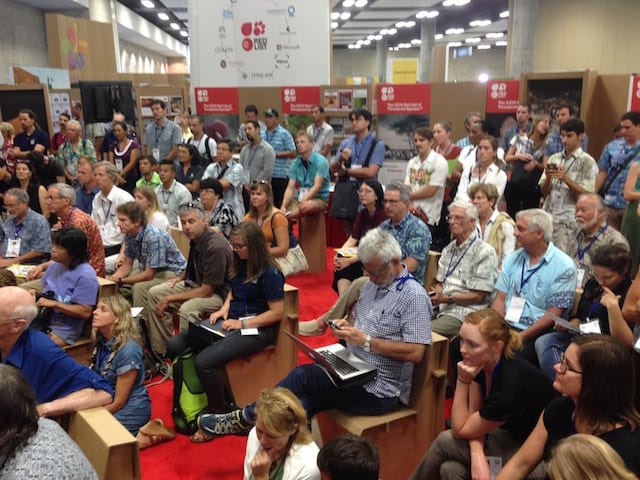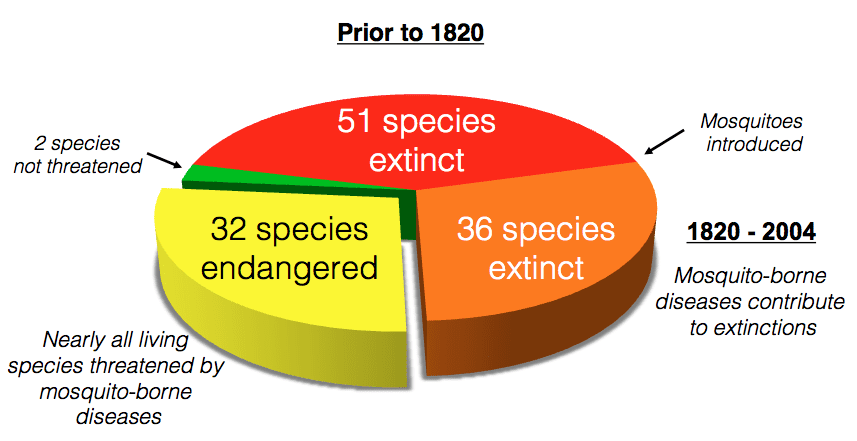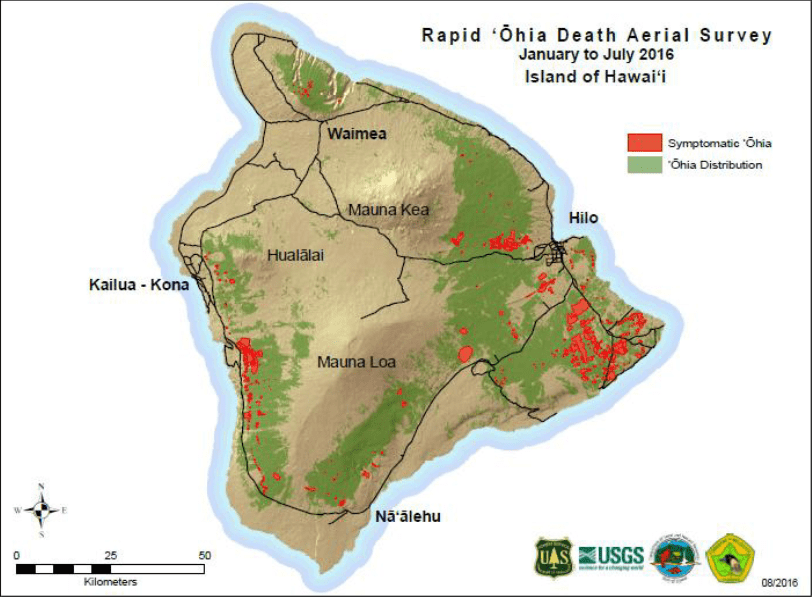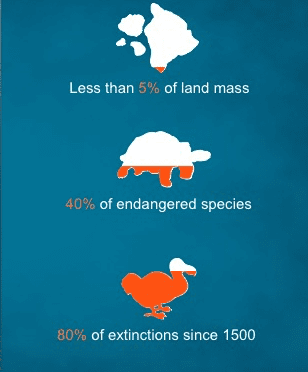September 4 – Workshop Session
“Genetic Rescue: Can new genomic tools solve conservation problems such as exotic wildlife diseases and destructive invasive species?”
At this session, speakers delved beyond on the topic of mosquito-borne diseases and birds to encompass more pressing problems for Hawaii’s native ecosystems and potential genomic solutions. Hawaii is home to a number of critical conservation issues that have proven extremely difficult, or impossible, to solve:
- A rapidly spreading invasive fungus (Ceratocystis fimbriata), referred to as “Rapid Ohi’a Death,” threatens Hawaii’s most important native tree, the ‘ōhi‘a. Since 2012, the fungus has killed hundreds of thousands of ‘ōhi‘a trees, a keystone species in the Hawaiian forest. A solution has yet to be found .
- Many of Hawaii’s native birds are being driven to extinction by avian malaria carried by invasive mosquitoes brought here a hundred years ago. Native bird species have no resistance. Avian diseases have contributed to the extinction of 34 Hawaii-endemic forest birds and threaten 21 of the remaining 32. Climate change is compounding this problem
- Similar to most Pacific islands, Hawaii’s native birds and plants suffer severely from predation by invasive rats and mice, a leading cause of extinctions on islands. Eradicating invasive rodents reverses this problem, present on 90% of our world’s islands. However, current conservation tools have serious limitations that slow the rate, or altogether prevent, such restoration projects.
Countries all over the world, and island nations in particular, face similar conservation problems.
Once again, it was standing room only as Sam ‘Ohukani’ōhi‘a Gon, III opened the Genetic Rescue workshop with a chant to Kū, the Hawaiian god of governance and beautifully illustrated the significance of the ʻōhiʻa tree, known as ʻōhiʻa lehua, to the indigenous people of Hawaii. The ʻōhiʻa is a keystone species to Hawaii’s forests – the first colonizer of new lava flows and the dominant tree from lowlands to high peaks, ranging in size from a hundred feet high to just six inches tall in the wettest bogs. The ʻōhiʻa has coevolved with Hawaii’s honeycreepers, and like the honeycreepers it now faces extinction due to disease: a fungal blight.

Expansion of Impacted Forests / Rob Hauff / State of Hawaii, Division of Forestry and Wildlife
The fungus (known as Rapid Ohi’a Death) has killed hundreds of thousands of trees since 2012. On Hawaii Island, 47,000 acres, representing 9% of its surveyed forest, are infected – an increase from 38,000 acres in February 2016. The loss of this tree would mean the collapse of Hawaii’s native forests. Given the significant impact of this disease, all conservation tools need to be explored. With the use of state-of-the-art genomics, there may be hope to better diagnose and maybe save the trees. One powerful option is to use genomic analysis to identify whether any trees have developed resistance to the disease. If so, it might lead to a potential cure.
Like the ʻōhiʻa tree, the American chestnut tree suffered from an invasive fungal blight, causing its virtual extinction, But researchers at the State University of New York’s College of Environmental Science and Forestry have restored the chestnut’s genetic ability to combat the fungus using a wheat gene. Andy Newhouse, of the American Chestnut Research and Restoration Project, shared how the engineered chestnut trees are now able to produce an enzyme that neutralizes the effects of the blight – resulting in trees that are 100% immune to the disease. Because of this effort, eastern America’s once most abundant tree is poised to make a comeback, a hundred years after their obliteration from the landscape. A similar method could save the ʻōhiʻa tree.

Island Extinctions / Karl Campbell / Island Conservation
The workshop concluded with the most notorious island conservation problem – invasive rodents. Island Conservation scientist Karl Campbell outlined the need for eradicating invasive species on islands: 40% of the world’s endangered species live on islands all threatened by invasive species, especially rodents. Ecosystems have shown extraordinary resilience once invasive species are removed. On Pinzon Island in the Galapagos, the resident giant tortoise species successfully hatched offspring for the first time in over a century, just 6 months after invasive rats were removed from the landscape. That success took years of planning and execution, with much labor devoted to mitigating the risk posed by the rodenticide.
Rodenticides are the only efficient tool that conservationists have to eliminate rodents on islands, but collateral damage to native wildlife and potential lingering toxicity in the environment are the side effects of its use. It is also a limited tool for scaling up to the large landscapes of many islands in dire need of rodent removal.
For this reason, Island Conservation is developing gene drive techniques to employ on islands in the future, which will skew sex ratios of the invasive rodent population. The basic concept is that when gene drive male rodents are introduced to an island their sex-determining genes will spread each generation, turning the entire population male and creating a final generation. There are no toxic side effects to native wildlife in the process and a system that can scale up to large landscapes.
Kevin Esvelt, of the Massachusetts Institute of Technology’s Media Lab, presented his laboratory research on self-limited gene drives, which he hopes to eventually employ with New England white-footed mice to spread a rare, but native, gene throughout the population, which will reduce transmission of Lyme disease. Esvelt heads the Media Lab’s Sculpting Evolution group, which invents new ways to study and influence the evolution of ecosystems. The group carefully and openly develops and tests its methods, focusing on addressing difficult ecological problems for the benefit of humanity and the natural world.



 The public event drew a jam-packed audience, with the crowd bleeding into the isles of the main exhibition floor.
The public event drew a jam-packed audience, with the crowd bleeding into the isles of the main exhibition floor.



